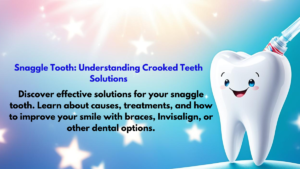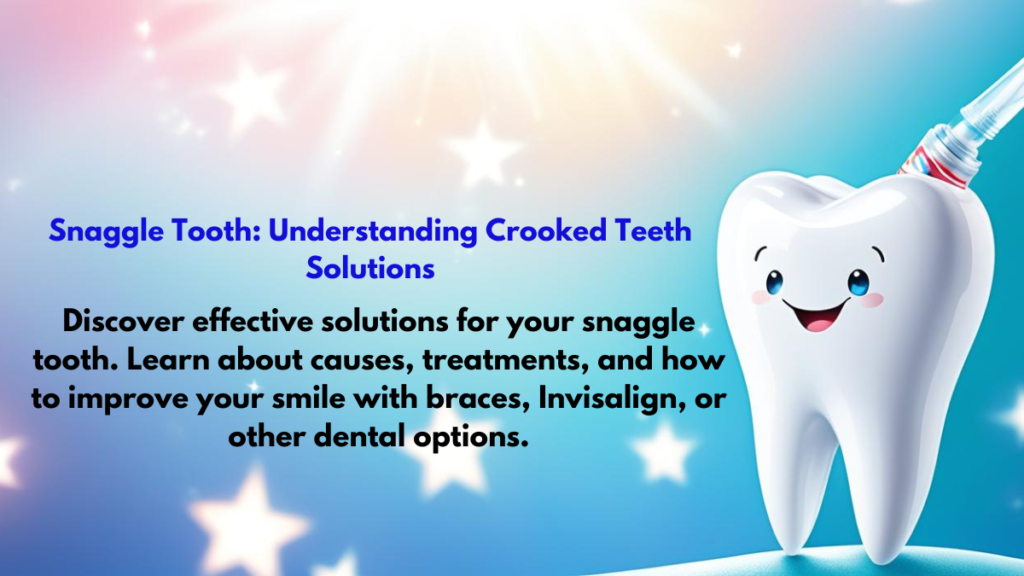Having a snaggletooth is quite common. It’s a tooth that sticks out or looks different from the others. It can happen due to crowded teeth, big teeth, or losing teeth early. A snaggletooth can make you feel self-conscious and can cause oral health problems if not fixed.
But don’t worry, there are ways to fix a snaggletooth and make your smile shine. You can choose from traditional braces, Invisalign, or veneers. These options can straighten your teeth, improve your bite, and make your mouth healthier. We’ll look at why snaggleteeth happen, the problems they can cause, and how to fix them for a better smile.
Decoding the Snaggle Tooth Phenomenon
A snaggletooth is a tooth that looks twisted or sticks out. In the US, it’s not seen as a plus for a smile. Having a snaggle tooth can really affect how someone feels about their looks.
Defining a Snaggle Tooth
A snaggletooth is a tooth that’s not in line with the others. It can look odd because it’s twisted or sticks out. This usually happens on the front teeth, like the upper incisors.
Snaggle Tooth: Aesthetic Quirk or Oral Health Issue?
Some see a snaggletooth as unique and cute. But in the US, it’s not seen as ideal. It can cause problems like trouble chewing, more cavities, and cleaning issues.
Cultural Perceptions and Personal Impact
Having a snaggletooth can really affect how someone feels about themselves. In the US, a straight smile is often the standard. So, people with a snaggle tooth might feel bad about their teeth. But in other places, it’s seen as special and pretty.
| Snaggletooth Perceptions | United States | Other Cultures |
|---|---|---|
| Aesthetic Perception | Generally not considered part of an ideal smile | May be viewed as a distinctive and attractive feature |
| Personal Impact | Can lead to self-consciousness and lack of confidence | May be celebrated as a unique and endearing characteristic |
Unraveling the Causes Behind Snaggletooth
If you have a snaggletooth, you might wonder why it happened. There are many reasons why someone might have a snaggletooth. Knowing the causes can help you find the best way to fix it.
Tooth overcrowding is a common cause of a snaggletooth. This happens when there’s not enough room for all your teeth to line up straight. It can be because of your genes or losing baby teeth too early.
Teeth grinding, or bruxism, is another reason for a snaggletooth. Grinding your teeth puts a lot of pressure on them, making them move out of place. Stress and your genes can make you more likely to grind your teeth.
Some people are just more likely to have teeth that don’t line up right because of their genes. This can lead to a snaggletooth.
| Cause | Description |
|---|---|
| Tooth Overcrowding | Insufficient space in the mouth for all teeth to erupt in a straight line, leading to crooked or misaligned teeth and a snaggletooth. |
| Teeth Grinding (Bruxism) | Excessive pressure on the teeth due to grinding or clenching, causing them to shift out of position and develop a snaggletooth. |
| Genetic Predisposition | Certain individuals are more prone to misaligned or crooked teeth, which can result in a snaggletooth. |
Knowing why you have a snaggletooth helps you choose the right treatment. By fixing the root cause, you can get a smile that’s straight and healthy.
Complications Associated With Untreated Snaggle Teeth
Not fixing a snaggletooth can cause many dental and oral health issues. It’s hard to clean around the misaligned tooth, leading to more plaque, snaggle tooth tooth decay, and gum disease. Also, bacteria can hide in the spaces around the tooth, causing chronic bad breath that affects social life.
Not treating snaggle tooth jaw issues can also mess with your bite and stress your jaw. This might lead to headaches, TMJ disorders, and jaw problems. These issues can affect your health, life quality, and how you interact with others.
Hygiene Challenges and Tooth Decay
Crooked teeth make it tough to keep your mouth clean, especially between teeth. This makes flossing and brushing hard, leading to faster enamel loss. Over time, this can cause cavities and abscess teeth.
Chronic Bad Breath and Its Social Repercussions
Crooked teeth hold onto bacteria, causing snaggle tooth bad breath if not cleaned well. This can hurt your social life and confidence. It can also make eating hard, leading to digestive problems.
Occlusion and Jaw Issues That May Arise
Misaligned jaws from crooked teeth can make chewing hard for some. The mental effects of snaggletooth dental problems can lower confidence and increase stress and anxiety. Crooked teeth can also break more easily due to jaw and tooth strain.
Exploring Treatment Options for a Snaggle Tooth
If you have a snaggletooth, you have many treatment options. The best choice depends on how bad your teeth are misaligned. Traditional braces are often used for serious cases and cost between $4,000 and $7,000. But, there are other options that might be better for you.
Clear or ceramic braces are good if you want something less visible, costing $4,000 to $8,000. Invisalign and at-home aligners are less invasive, costing $900 to $8,000. These are great for mild cases of snaggletooth.
For a minor snaggletooth, dental veneers and tooth contouring might work. Veneers cost between $2,000 and $24,000 for a few teeth. Tooth contouring is cheaper, at $50 to $500 per tooth, and can fix small misalignments or chips.
| Treatment Option | Cost Range | Treatment Duration |
|---|---|---|
| Traditional Braces | $4,000 – $7,000 | 12-14 months |
| Ceramic (Invisible) Braces | $4,000 – $8,000 | 12-14 months |
| Lingual Braces | $6,000 – $13,000 | 18-30 months |
| At-Home Aligners | $900 – $2,500 | 6-18 months |
| In-Office Aligners | $3,000 – $8,000 | 12-24 months |
| Veneers | $2,000 – $24,000 (for 4-6 teeth) | 1-2 appointments |
| Tooth Contouring | $50 – $500 per tooth | 1 appointment |
When looking into snaggletooth treatments, talk to a dental expert. They can check your teeth and suggest the best option for you. Whether it’s traditional braces, clear aligners, or a cosmetic fix, the aim is to get a smile that’s healthy and boosts your confidence.
Snaggle Tooth Solutions Without Traditional Braces
If you want a discreet or less invasive fix for your snaggletooth, there are options besides traditional braces. Invisalign and at-home aligners are great for mild to moderate misalignment. They are clear and move your teeth slowly over months, taking from a few months to a year.
Dental veneers can also hide a snaggletooth. These are thin, custom shells that cover the front of your teeth. They cost from $500 to $4,000 for one veneer, and $2,000 to $24,000 for 4 to 6 veneers.
Tooth contouring is another option for those on a budget. It reshapes the tooth surface to look better and align properly. It costs $50 to $500 per tooth.
These treatments have many benefits, like being discreet and affordable. They’re perfect for those wanting to fix their snaggletooth without traditional braces.
Maintaining Oral Health After Correcting a Snaggle Tooth
Congratulations on fixing your snaggletooth! But, the job isn’t done yet. Keeping up with good oral hygiene is key to keeping your smile looking great. Here are some tips to help you keep your teeth healthy and straight after snaggletooth treatment.
Start by brushing the treated area gently. Use a soft-bristled toothbrush and move in a circular motion. Hard brushing can hurt the gums and upset the tooth that’s been moved. Don’t forget to floss, as it removes food bits and bacteria your brush might miss.
Adding an antiseptic mouthwash to your daily routine is a good idea. It kills bad bacteria and keeps your mouth fresh. Just make sure to use it as the instructions say.
Also, keep up with regular dentist visits for checkups and cleanings. Even with a fixed snaggletooth, you need to keep up with good oral care to avoid problems later. Your dentist can check on your teeth and gums and give you advice to keep your smile perfect.
By doing these simple things, you can keep your teeth healthy and looking good for a long time. Taking care of your oral health after fixing a snaggletooth is important. It helps you keep your smile looking great.
Conclusion
Snaggleteeth, or misaligned and protruding teeth, can cause insecurity and oral health issues if not treated. Understanding the causes, complications, and treatment options helps those with snaggletooth. This way, they can fix their smile’s appearance and function.
There are many ways to fix a snaggletooth, from traditional braces to discreet options like Invisalign and veneers. Getting professional dental care and keeping up with good oral hygiene is key for a healthier, more confident smile. Fixing snaggleteeth can greatly improve your oral health and overall well-being.
This article’s summary shows how crucial it is to know the causes, problems, and treatment options for snaggletooth. By taking steps to fix this dental issue, you can beat the challenges of misaligned teeth. This leads to a balanced, beautiful smile.
FAQ
What is a snaggle tooth?
A snaggle tooth is a tooth that doesn’t fit in with the others. It might be shaped oddly or stick out too much. This can happen if your teeth are crowded, you have big teeth, or if you lost teeth early on.
How can a snaggle tooth impact my oral health?
A snaggle tooth can cause problems like cavities, gum disease, bad breath, and bite issues. These problems can happen if you don’t get it fixed.
What are the common causes of a snaggletooth?
Snaggle teeth often come from crowded teeth, big teeth, losing baby teeth early, grinding, or your genes.
What are the treatment options for a snaggletooth?
You can fix a snaggle tooth with braces, Invisalign, veneers, or tooth shaping. The choice depends on how bad the teeth are misaligned.
Are there any alternatives to traditional braces for a snaggletooth?
Yes, you can use Invisalign, at-home aligners, dental veneers, or tooth shaping instead of traditional braces. These options are less noticeable and less invasive.
How can I maintain good oral health after correcting a snaggletooth?
Keep your teeth healthy after fixing a snaggle tooth by brushing with a soft toothbrush, flossing, and seeing your dentist regularly for check-ups and cleanings.


